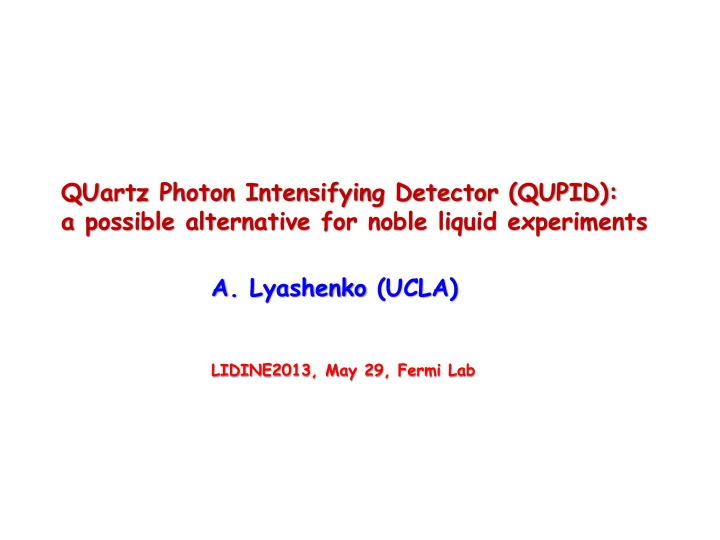

QUartz Photon Intensifying Detector (QUPID): a possible alternative for noble liquid experiments A. Lyashenko (UCLA) LIDINE2013, May 29, Fermi Lab
Motivation - Extremely low internal radioactivity: U + Th < 0.5 mBq, 60 Co < 0.5 mBq, 40 K < 5 mBq - High QE: >30% @178nm for Xe, @420nm for Ar - Hi Gain: >10 5 @-100C for Xe, @-180C for Ar - Clear Single PE peak: >4 peak/valley - Low Dark Count Rate: <100Hz @ -100C - Low afterpulsing rate: <2% in ~2uS - Good Cathode/Anode Pulse Linearity: ~24nA for cathode, 2.4mA for anode @10 5 - Good photocathode uniformity: +-15% - High PE collection efficiency: >80% - Good timing properties: pulse width <10nS
What is QUPID? QUartz Photon Intensifying Detector h ν PC (-6kV) e- Al coating APD (0V) Made of Synthetic Silica
QUPID production version
QUPID backgrounds: Gamma Energy range [2 - 18] keVee • Multiple hit cut • S2/S1 cut at 99% rejection • QUPID 3" PMT R11410-20 XENON1T 0 cm 5 cm 10 cm GATOR GATOR (2.3 t) (1.6 t) (1.1 t) (10 QUPIDs) (10 PMTs) Evts/year Evts/year Evts/year mBq/unit mBq/unit <560 <0.5 0 <14 <18 U-238 35 0.24 0.02 0.4 ± 0.1 0.9 ± 0.2 Th-232 23 0.14 0.01 0.3 ± 0.1 0.9 ± 0.3 Rn-226 55 0.32 0.02 7 ± 1 12 ± 2 K-40 <4.9 <0.21 <0.02 <0.21 1.3 ± 0.2 Co-60 Total Gamma <0.07
QUPID backgrounds: Neutrons SOURCES-4C assuming Th at 0.4(2) mBq • - About a factor 6 lower than GATOR upper limit • Geant4 - Energy range [5 - 40] keVnr - Multiple hit cut Requirement: < 0.1 n/y in [5 - 40] keVnr from the QUPIDs QUPID 3" PMT R11410-20 XENON1T 10 cm 20 cm GATOR GATOR (1.1 t) (0.5 t) mBq mBq mBq mBq 9 27 U <15 <19 2 6 Th 0.4 ± 0.1 0.9 ± 0.2 Allowing 0.1 n/y in the signal phase space: U activity must be • reduced to 9 mBq while Th already satisfy the specifications
QUPID Characteristics: QE Argon type Quantum Efficiency [%] 40 30 Xenon type 20 Xenon (178 nm) 10 Argon + TPB (420 nm) 0 150 250 350 450 550 Wavelength [nm]
QUPID Characteristics: Gain BA0089 Bombardment Gain BA0089 Avalanche Gain 1000 1500 1250 100 1000 Gain Gain 750 10 20C 500 20C -100C 250 -100C 1 0 0 200 400 600 0 1 2 3 4 5 6 7 8 9 10 APD Reversed Bias [V] PC Bias [kV] Total Gain = 100 x 1300 =1.3*10 5 @ -100C
QUPID Characteristics: SPE peak -7kV on PC -6kV on PC Gain ~1.4*10 5 Gain ~1.15*10 5 1PE Peak/Valley ~7.5 Peak/Valley ~6 1PE 2PE 2PE 3PE 3PE 4PE 3PE -8kV on PC 2PE Gain ~1.7*10 5 1PE Peak/Valley ~7.5 1PE 2PE 3PE Excellent photon counting capability 4PE Peak/valley >4
QUPID Characteristics: Dark Count Rate 4000Hz @ 1PE threshold,20C 70Hz @ 1PE threshold,-150C >100Hz Dark Count rate at low temperature
QUPID Characteristics: Linearity • For 2.5MeV gamma calibration event, – Assumption : • Pulse Charge: 1.5*10 4 e- / pulse @ 3 PE/keV • Pulse width: 1 s • Rate : ~1kHz – Required Linearity • Pulse Linearity (Cathode) : 24nA • Pulse Linearity (Anode) : 2.4mA
QUPID Characteristics: Linearity Cathode Anode Gain 10 5 , Rate 600Hz Gain 10 5 , Rate 600Hz 5% level 5% level 100nA @-150C 3mA 1000nA 20nA @-100C @-110C @-170C Capable of high calibration rate of 600Hz for 2.5MeV gammas
QUPID Characteristics: Uniformity Cathode Anode Photocathode and anode showed a uniform response to 80% across the face
QUPID Characteristics: PE Collection Collection Efficiency >80% across the entire photocathode area
QUPID Characteristics: Timing properties Transit Time Phototube Rise Time Fall Time Pulse Width Spread R11065 4.2 ± 1.1 ns 10.0 ± 1.0 ns 8.0 ± 0.6 ns 7.4 ± 0.5 ns R8520 1.9 ± 0.2 ns 2.9 ± 0.2 ns 4.4 ± 0.1 ns 1.1 ± 0.1 ns QUPID 1.8 ± 0.1 ns 2.5 ± 0.2 ns 4.20 ± 0.05 ns 160 ± 30 ps
QUPID Operation in LXe Control Cryocooler Panel Liquid Xenon Chamber 57Co and 210Po Source Cooling System QUPID Cryostat Xenon Aluminum and Bottle PTFE QUPID Holder Getter Polyethylene PTFE QUPID Support Support Cylinder Circulation Pump
QUPID Operation in LXe γ (122 keV) α (5.3 MeV) 2 pe/keV 1.6 pe/keV
7QUPID Array Operation in LAr CAEN V1720 (250Mhz Digitizer)
7QUPID Array Readout CAEN V1720 Detector APD Receiver RFBay Inc. LNA1440 FADC QUPID 4M Amp 250 MHz samples G=160,000 X 60 12 Bits Memory 1 nF (1 kV) Coax Cable (10 m) Low Range ( < 80 keV) APD FADC 4M 250 MHz samples 100 k 12 Bits Memory 500 M High Range ( < 5 MeV) (10 m) (8 ch / board) -6 kV - 300 V (APD Bias) (Photo cathode) HV Power Supply
7QUPID Array Operation in LAr Signals from 4 QUPIDs observed in LAr in LAr 1PE 2PE 3PE
Summary • Low radioactivity:< 1 mBq – < 0.1 neutron / year • Special Photocathode: Bialkali LT – > 35 % QE at 170 – 450 nm (Ar-type & Xe-type) – Low resistivity even at Liquid Ar temperature (-185 o C) • True photon counting. – 1, 2, 3… photoelectron peaks clearly visible. – TTS = 160 ps (to be compared with 6 ns of 3” PMT) • Good PE Collection, Good Linearity, Good PC Uniformity • Simple HV supply – Resister chain not necessary • Successful operation in Liquid Xenon and Argon
Recommend
More recommend